►Fiat Grande Panda Hybrid driven
►A compellingly all-round package
►A refined and composed urban gem
If you love the freshness and originality of the new Grande Panda Electric but electricity doesn’t work for you, then this new Hybrid model will scratch your itch. Its mild hybrid hardware combines a turbo-charged 1199cc three-pot petrol unit with a 21kW electric motor and a 48V Li-ion battery, driving the front wheels through a six-speed double-clutch gearbox.
So you get a real-word 500 miles between refills, surprisingly perky performance and an effortless driving experience, all wrapped up in the coolest bit of automotive design we’ve seen in this sector for a looong time. And the best bit? The range starts at a mustard-keen £18,035, a significant £2,940 saving over the electric version.
Like its EV sibling, the hybrid Panda rides on Stellantis’ ubiquitous Smart Car ‘multi-energy- architecture, and unlike the inoffensively safe Citroen C3 and Vauxhall Frontera that are also underpinned by the Smart Car platform, the Grande Panda is a design blinder.
Design chief Francois Leboine and his team have packed it inside and out with witty and intelligent hat-tips and nose-taps to Pandas of the past, without losing sight of its primary role of providing affordable and practical family transport. That pixelated grille was inspired by the by the nocturnal view of the Lingotto complex, Fiat’s historical Torinese headquarters, and its many illuminated windows. The flanks are stamped large with Panda, the Fiat logo sits atop each wheelarch, that striated panel on the C-pillar spells outs Fiat, and those sharp-edged rear lights reflect the set-square angles of Giorgetto Giugiaro’s 1980 original. Excellent stuff.
At a glance
Pros: arresting design inside and out; exceptional value; smooth and composed to drive
Cons: ride can feel abrupt over rougher roads; snug rear accommodation
What’s new?
The Grande Panda effectively reboots Fiat in the UK, finally giving its tumbleweed dealerships something to be genuinely excited about. Cars can be ordered now, with first deliveries expected in September in time for the registration plate change. Sales are confidently predicted to top 5000 units by the end of the calendar year, with a sales split 40:60 between the all-electric and hybrid -petrol models.
The Fiat suits in Europe are also rubbing their hands in glee – the Italian marque is easily the biggest shifter of metal within the Stellantis group, and according to Gaetano Thorel, head of Fiat and Abarth in Europe, the Panda family should keep Fiat in the top spot by racking up annual sales of 300,000 across 60 markets that include Brazil, Japan, Turkey and Algeria.
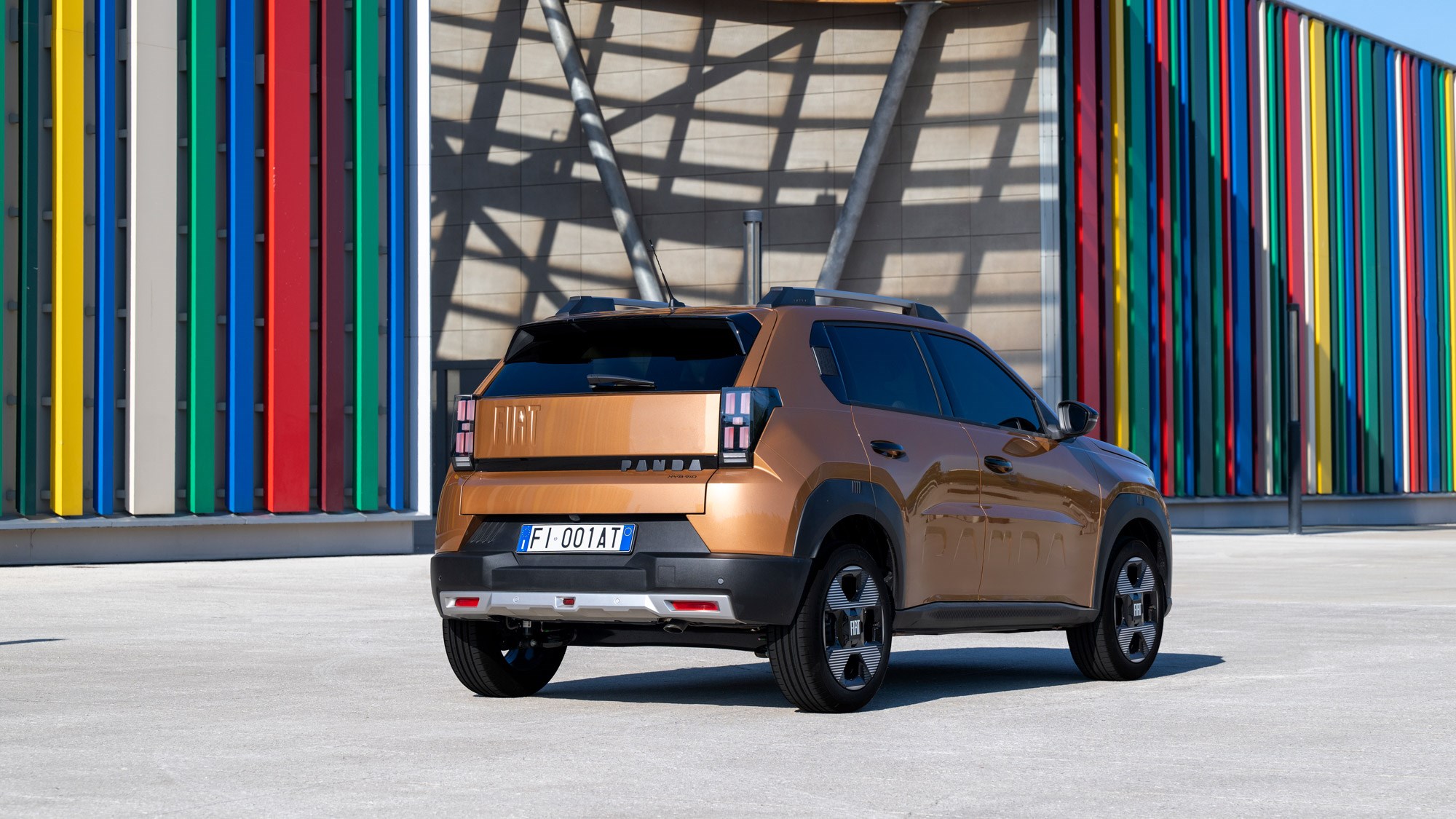
Oh, and in the UK we’re going to refer to this as the Panda, not just as Grande Panda is a mouthful, but because the outgoing Panda is no longer on sale, whereas in Italy it is. So Fiat calls this ‘old’ Panda the Pandina (little Panda) and Leboine’s new masterpiece is called Grande Panda. That all clear…?
What are the specs?
The Hybrid is a one-engine model – under the bonnet is a three-cylinder turbo-charged 1199cc-litre three-pot that drives the front wheels through a six-speed double-clutch gearbox. Fiat calls it the T-Gen3, and it’s a version of the jack-of-all-trades engine that serves duty in other Stellantis models. Combining a 48V Li-ion battery and a 21kW electric motor, complete with inverter and control unit, it collectively generates 108bhp at 5500rpm and a useful 151lb ft at 1750rpm.
The 0-62mph dash takes a relaxed 10 seconds, and the shouting is all over by 99mph. Fiat’s engineers opted for the more economical Miller Cycle, which keeps inlet valves open for longer to reduce the amount of air-fuel mixture that gets compressed. This in turn lowers both pressure and temperature in the cylinder. The result is lower fuel consumption and reduced emissions at low engine speeds, with the combination of electric motor and turbo kicking in early to bolster the torque curve.
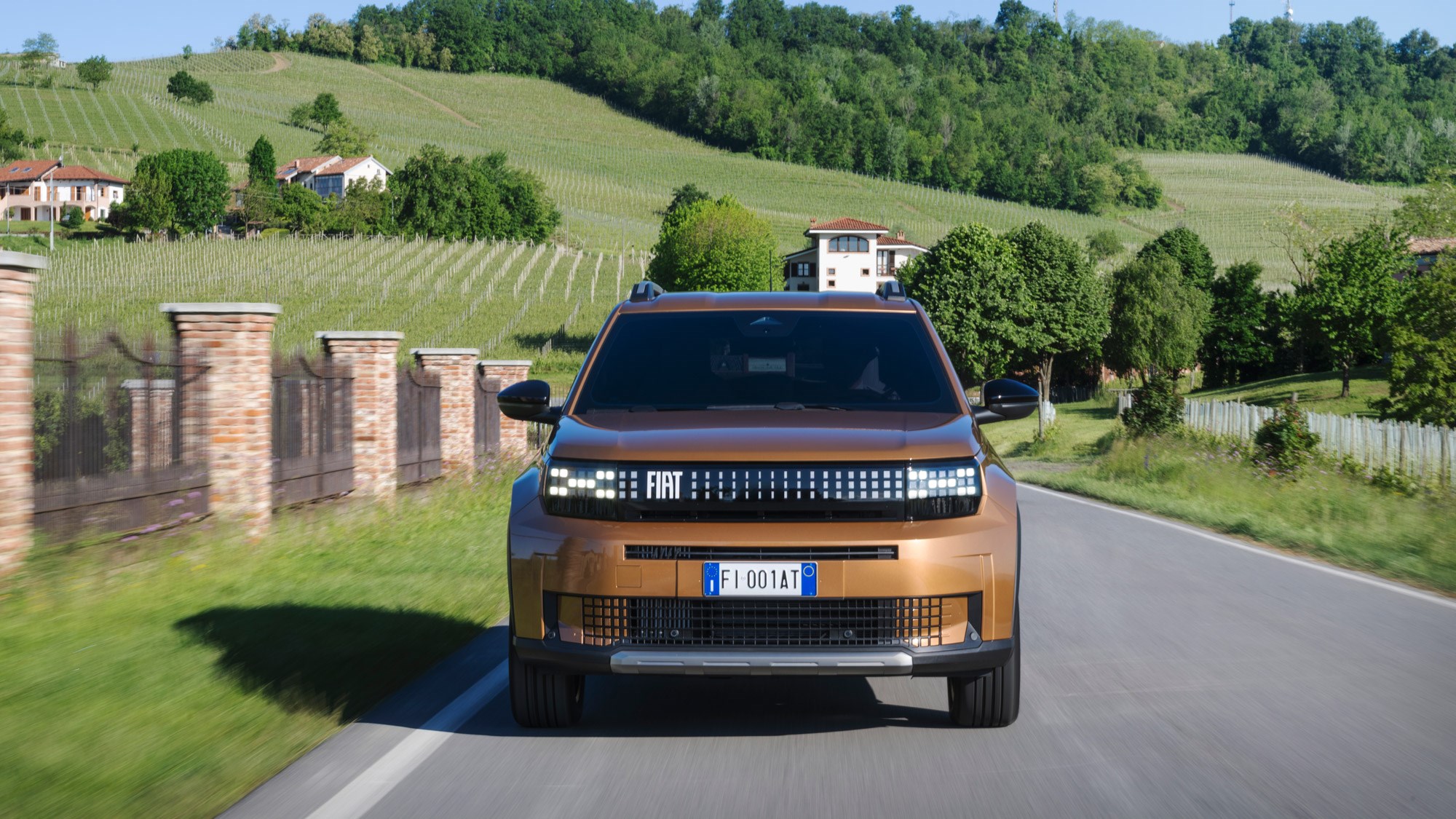
Buyers will have the choice of three trim levels – Pop, Icon and La Prima. On their 16-inch wheels, the Pop and Icon return 115g/km and 56.5mpg on the combined cycle, with the La Prima flagship on its 17-inch alloys posting figures of 117g/km and 55.5mpg. That means an on-paper range of around 500 miles. Our enthusiastically tackled tour of Turin and its surrounding winelands, undertaken in torrential downpours and on a tight timeline, resulted in 45mpg away from town and 52mpg within it.
How does it drive?
For a small Italian family car primarily aimed at urbanites, the Panda goes about its business with a poise and maturity that is as unexpected as it is welcome. The hybrid powertrain is smooth and refined, delivering its modest – but perfectly acceptable – performance with a muted three-cylinder thrum, and the six-speed transmission slips swiftly and unobtrusively through the gears.
It feels friskier and more tail-up alert than its performance figure would suggest, helped by a handily brisk step-off that made short work of gap-chasing and congested roundabout in rush-hour Turin. Accelerate smartly from standstill and you can feel the electric motor-enhanced torque fill in the gaps between shifts, maintaining momentum as its economy-oriented mapping hunts out top gear as quickly as possible.
There’s a very occasional hesitancy when coming on and off the power while the engine, motor and transmission have a quick discussion about who’s doing what, but for the most part, the hybrid system does a solid job of providing a smooth and linear surge of acceleration. Sure, it’s not quite the same level of seamless acceleration as the EV version, but it’s pretty close, and does a good job of disguising the Panda’s sticky 1380kg kerb weight.

The Fiat will run silently on electricity for just over half a mile at speeds below 18mph, which is ideal for parking, low-speed manoeuvres and stop-start congestion. Come off the power and regen braking subtlety kicks in to charge the battery – not quite a full-blown one-pedal mode but very useful around town. And given its back-pocket dimensions and metropolitan remit the Panda will happily whirr its way up to motorway speeds without needing a sundial to measure progress. At these speeds, wind and road noise, your constant background companions, drown out any drivetrain rumble. We suspect those roof bars shoulder much of the blame, and the Goodyear 205/55 R17 tyres seem very sensitive to changes in road surfaces.
The electric-assist steering is pretty numb, but it has a well-judged weight to it, and at 3.1 turns between locks it’s fast enough for urban work. Braking performance from the all-disc set up is strong, as we discovered when an articulated truck ahead of us started to aquaplane across some particularly sodden bitumen. Pity the turning circle is an unexceptional 10.9m.
The Panda’s MacPherson strut front and twist-beam rear suspension does a decent job of sponging away most intrusions, with the calmness of the cabin only broken by the pronounced ridges, expansion joints and potholes that pepper Turin’s long-suffering roads. Given its role as urban transport, we’d have liked a dash more Citroen-esque compliance to the low-speed ride, which often errs on the wrong side of brittleness.
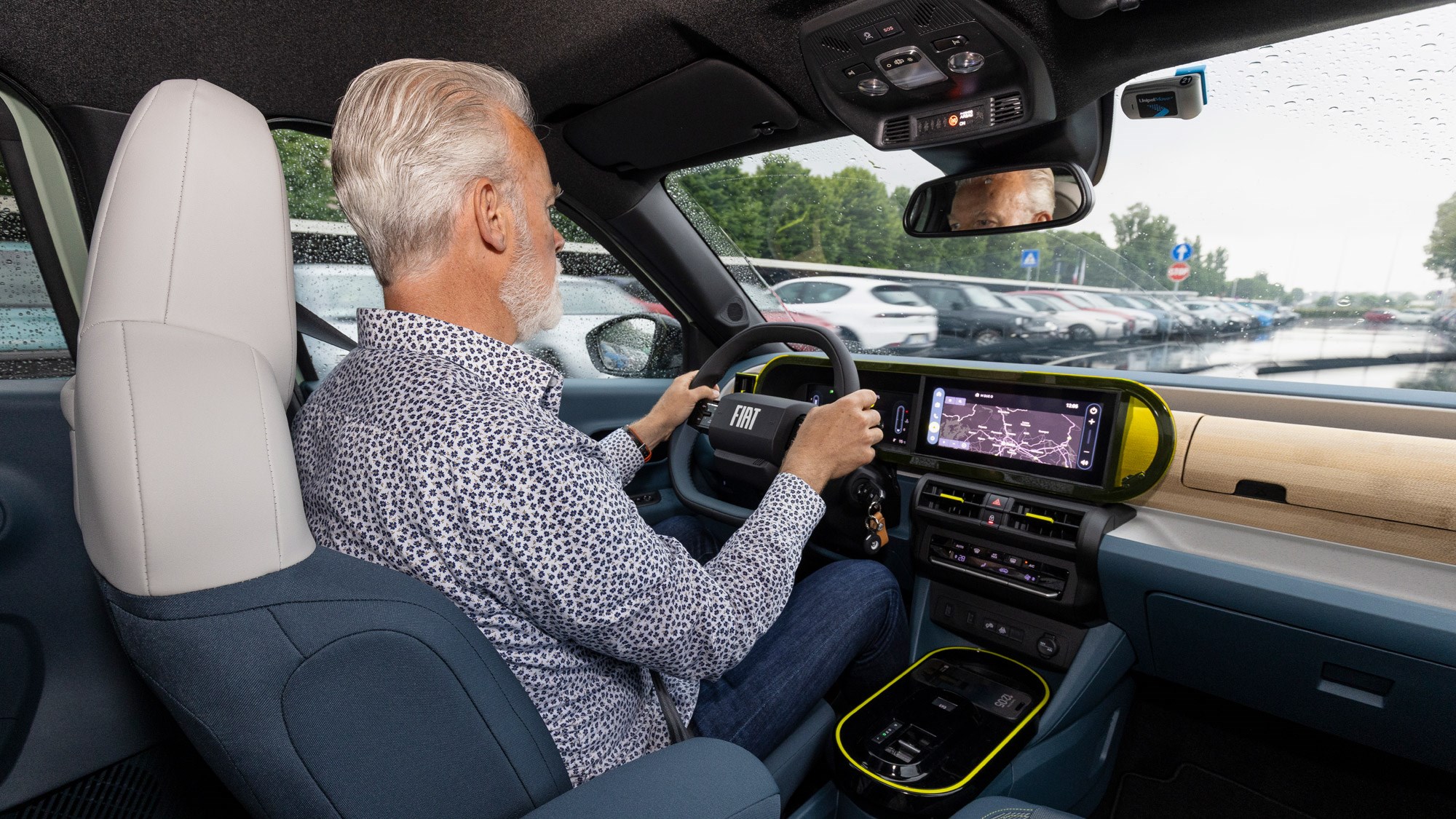
It’s a neat and tidy handler, too. Body control is better than expected, with even the most enthusiastically tackled hairpin-heavy hillsides refusing to fluster the Panda’s check on excessive roll, pitch and dive. But then you’ll do this only once, because it’s a composed and undemanding car to drive that invites and rewards a neat and calm driving style – and rightly so. There’s nothing to invite any kind of enthusiastic driving – there are no gearshift paddles, no rev counter and no drive modes – hell, there’s not even a display to indicate which gear you’re in, so you simply drop into D, relax, and let the drivetrain do its thing.
What about the interior?
The Hybrid shares its superb interior with the Panda EV, and it’s a thing to behold – there’s humour and entertainment at every turn. Inspired by the test track atop the Lingotto building, the pill-shaped dashboard features a model of Giorgetto Giugiaro’s original Panda in the bottom corner. That test-track theme pops up repeatedly – in the centre console, door handles and instrument displays. The door cards are emblazoned with the Fiat badge, those boxy left and right airvents recall the sharp-edged silhouette of the original Panda.
The block-patterned seats are embroidered with the prepositionally-challenged ‘Panda Made With Love In Fiat’ slogan, but we get the idea. And then there’s the ‘Bambox’ dash-top storage unit wrapped in bamboo-based fabric. Dayglo yellow details, denim-style trim, ovals and circles and sharp-edge rectangles, bamboo weave fabric – none of this shouldn’t work but it really does. Certainly well enough to compensate for some of the unyielding plastics used in the cabin.
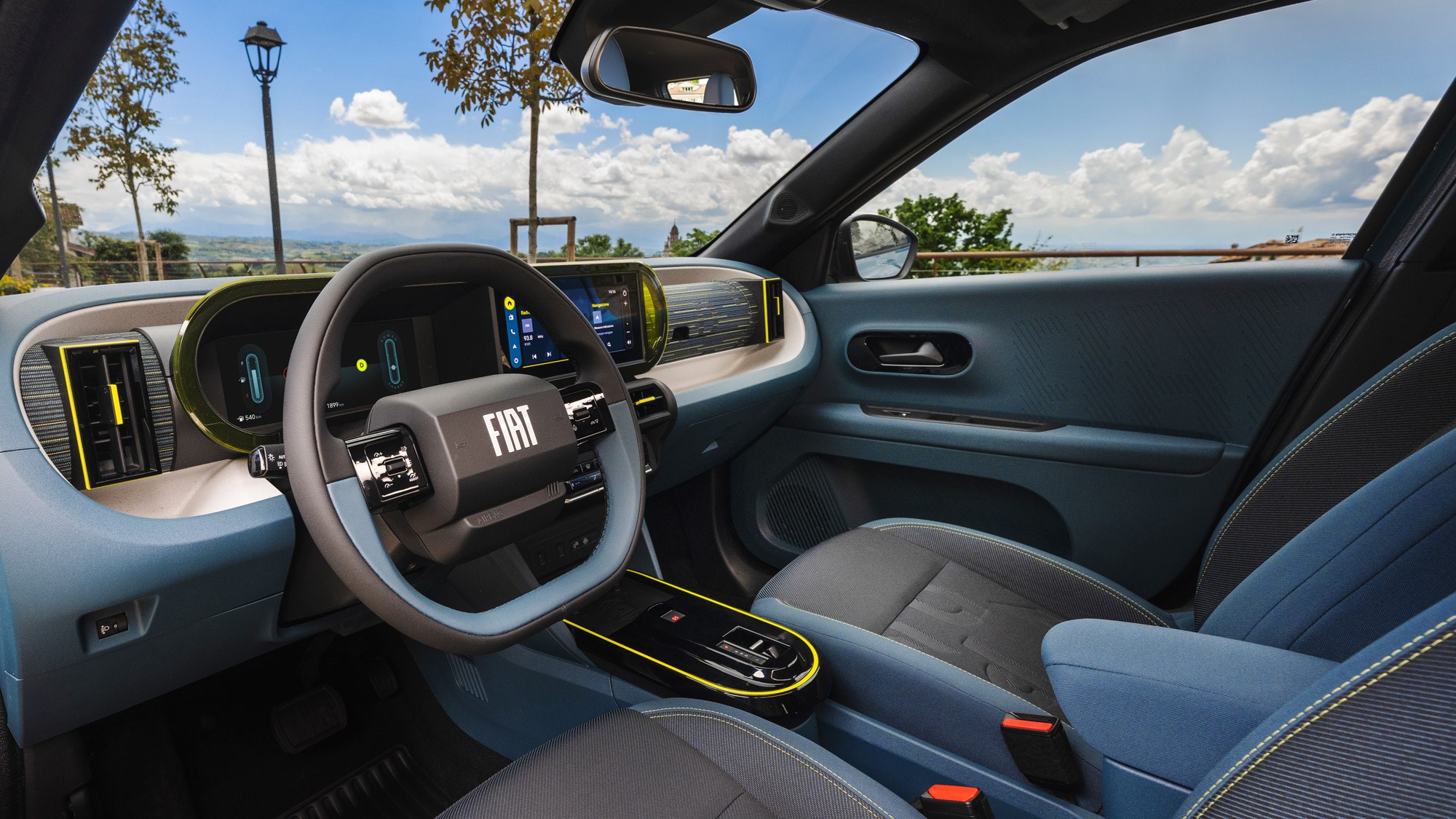
It may be dominated by those design touches, but Fiat’s design team didn’t forget about comfort and practicality. The deeply cushioned seats are very supportive, it’s spacious up front and just roomy enough in the back – and rather dark – to accommodate two tall adults on longer trips, or three on short commutes. Visibility is excellent, and the Hybrid also gets a larger boot than its electric counterpart – 412 litres versus the EV’s 361 litres. Folding the split rear seats forward extends this to 1366 litres (1315 litres for the electric model).
Before you buy (trims and rivals)
UK buyers can choose from three trim levels – Pop, Icon and La Prima. The keenly priced Pop is £18,035, a further £1000 puts an Icon on your parking spot and you’ll need £21,035 for the La Prima range-topper. Standard specification levels include: a 10-inch digital instrument panel, front and rear LED lights, cruise control, aircon, rear parking sensors and an infotainment system with 10.25-inch screen. Wireless Apple CarPlay and Android Auto are standard, as are six airbags, mandatory ADAS features, and plastic covers for those 16-inch steel wheels.
If you want 60:40 split folding rear seats, silvered roofbars, front and rear skid plates, and privacy glass then opt for the Icon, with La Prima buyers get 17-inch alloys, auto lights and wipers, wireless smartphone charging, and keyless entry, among other features.
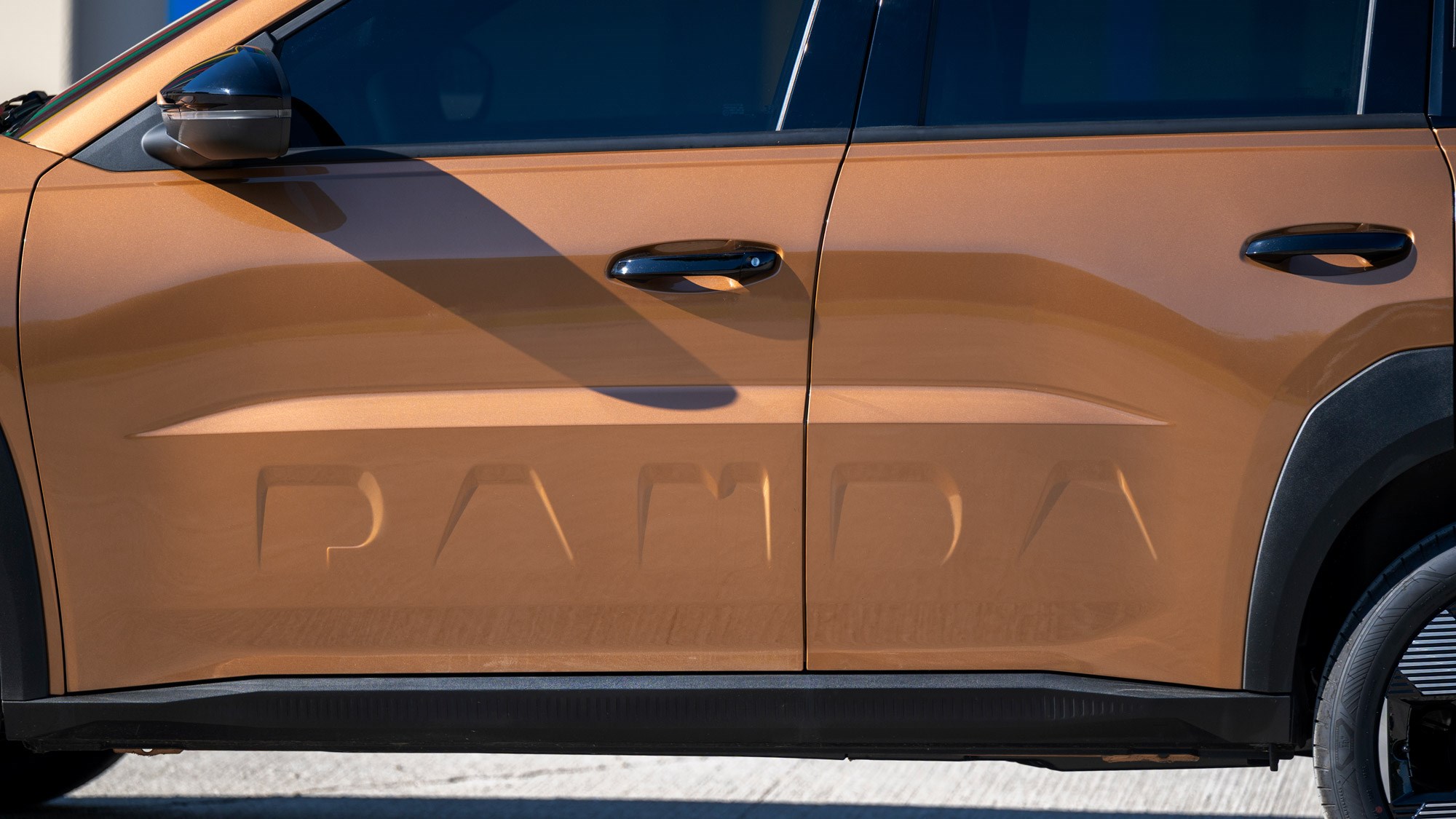
Oh, and don’t be put off by Shaggy. In one the automotive sector’s weirder marketing moves, Fiat has teamed up with the Jamaican rapper to re-release his 1995 hit Boombastic for the launch of the Panda, tweaking the earworm lyrics from ‘Fantastic’ to ‘Pandastic’. Just step back and wonder at the level of cringe, ask WTAF, and move quickly on.
Verdict
Fiat’s most successful models have been small cars with big personalities, those that balance equally generous levels charm, affordability and practicality. The new hybrid Grande Panda is entirely fit for purpose and it ticks all the big boxes – affordability, versatility, frugality and practicality – with a high-fiving exuberance and confidence that its rivals will struggle to match.
The sharp-suited Renault Clio E-Tech is an excellent all-rounder with a dynamic glint in its eye, but you’l need to find a larger chunk of money. The more expensive MG3 lacks the Panda’s polish and refinement – not a sentence we’d ever thought we’d write about a small Fiat. It’s arguably the Citroen C3 – a rival from within the Stellantis family – that comes close to matching the Panda’s style, affordability and versatility. We like the Panda, and think it should be in the top three of your test-drive list. Just ensure your experience at your local Stellantis dealer is as positive and enjoyable as the Panda’s driving experience, before sealing the deal.